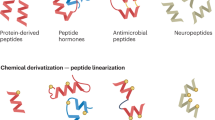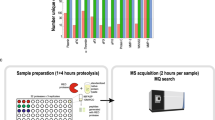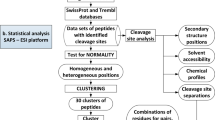Abstract
The number of known proteases is increasing at a tremendous rate as a consequence of genome sequencing projects. Although one can guess at the functions of these novel enzymes by considering sequence homology to known proteases, there is a need for new tools to rapidly provide functional information on large numbers of proteins. We describe a method for determining the cleavage site specificity of proteolytic enzymes that involves pooled sequencing of peptide library mixtures. The method was used to determine cleavage site motifs for six enzymes in the matrix metalloprotease (MMP) family. The results were validated by comparison with previous literature and by analyzing the cleavage of individually synthesized peptide substrates. The library data led us to identify the proteoglycan neurocan as a novel MMP-2 substrate. Our results indicate that a small set of libraries can be used to quickly profile an expanding protease family, providing information applicable to the design of inhibitors and to the identification of protein substrates.
This is a preview of subscription content, access via your institution
Access options
Subscribe to this journal
Receive 12 print issues and online access
$209.00 per year
only $17.42 per issue
Buy this article
- Purchase on Springer Link
- Instant access to full article PDF
Prices may be subject to local taxes which are calculated during checkout



Similar content being viewed by others
References
Matthews, D.J. & Wells, J.A. Substrate phage: selection of protease substrates by monovalent phage display. Science 260, 1113–1117 (1993).
Smith, M.M., Shi, L. & Navre, M. Rapid identification of highly active and selective substrates for stromelysin and matrilysin using bacteriophage display libraries. J. Biol. Chem. 270, 6440–6449 (1995).
Rano, T.A. et al. A combinatorial approach for determining protease specificities: application to interleukin-1β converting enzyme (ICE). Chem. Biol. 4, 149–155 (1996).
Backes, B.J., Harris, J.L., Leonetti, F., Craik, C.S. & Ellman, J.A. Synthesis of positional-scanning libraries of fluorogenic peptide substrates to define the extended substrate specificity of plasmin and thrombin. Nat. Biotechnol. 18, 187–193 (2000).
Harris, J.L. et al. Rapid and general profiling of protease specificity by using combinatorial fluorogenic substrate libraries. Proc. Natl. Acad. Sci. USA 97, 7754–7759 (2000).
Birkett, A.J. et al. Determination of enzyme specificity in a complex mixture of peptide substrates by N-terminal sequence analysis. Anal. Biochem. 196, 137–143 (1991).
Petithory, J.R., Masiarz, F.R., Kirsch, J.F., Santi, D.V. & Malcolm, B.A. A rapid method for determination of endoproteinase substrate specificity: Specificity of the 3C proteinase from hepatitis A virus. Proc. Natl. Acad. Sci. USA 88, 11510–11514 (1991).
Arnold, D. et al. Substrate specificity of cathepsins D and E determined by N-terminal and C-terminal sequencing of peptide pools. Eur. J. Biochem. 249, 171–179 (1997).
Berman, J. et al. Rapid optimization of enzyme substrates using defined substrate mixtures. J. Biol. Chem. 267, 1434–1437 (1992).
Songyang, Z. et al. SH2 domains recognize specific phosphopeptide sequences. Cell 72, 767–778 (1993).
Songyang, Z. et al. Use of an oriented peptide library to determine the optimal substrates of protein kinases. Curr. Biol. 4, 973–982 (1994).
Songyang, Z. et al. Recognition of unique carboxyl-terminal motifs by distinct PDZ domains. Science 275, 73–77 (1997).
Yaffe, M. B. et al. The structural basis for 14-3-3:phosphopeptide binding specificity. Cell 91, 961–971 (1997).
Johnson, L.L., Dyer, R. & Hupe, D.J. Matrix metalloproteinases. Curr. Opin. Chem. Biol. 2, 466–471 (1998).
Woessner, J.F. & Nagase, H. Matrix metalloproteinases and TIMPs. (Oxford University Press, Oxford, UK; 2000).
Nagase, H. & Fields, G.B. Human matrix metalloproteinase specificity studies using collagen sequence-based synthetic peptides. Biopolymers 40, 399–416 (1996).
Fields, G.B., Van Wart, H.E. & Birkedal-Hansen, H. Sequence specificity of human skin fibroblast collagenase. J. Biol. Chem. 262, 6221–6226 (1987).
Teahan, J., Harrison, R., Izquierdo, M. & Stein, R.L. Substrate specificity of human fibroblast stromelysin. Hydrolysis of substance P and its analogues. Biochemistry 28, 8497–8501 (1989).
Netzel-Arnett, S., Fields, G., Birkedal-Hansen, H. & Van Wart, H.E. Sequence specificities of human fibroblast and neutrophil collagenases. J. Biol. Chem. 266, 6747–6755 (1991).
Niedzwiecki, L, Teahan, J., Harrison, R.K. & Stein, R.L. Substrate specificity of the human matrix metalloproteinase stromelysin and the development of continuous fluorometric assays. Biochemistry 31, 12618–12623 (1992).
Netzel-Arnett, S. et al. Comparative sequence specificities of human 72- and 92-kDa gelatinases (type IV collagenases) and PUMP (matrilysin). Biochemistry 32, 6427–6432 (1993).
Nagase, H., Fields, C.G. & Fields, G.B. Design and characterization of a fluorogenic substrate selectively hydrolyzed by stromelysin 1 (matrix metalloproteinase-3). J. Biol. Chem. 269, 20952–20957 (1994).
Deng, S.-J. et al. Substrate specificity of human collagenase 3 assessed using a phage-displayed peptide library. J. Biol. Chem. 275, 31422–31427 (2000).
McGeehan, G.M. et al. Characterization of the peptide substrate specificities of interstitial collagenase and 92-kDa gelatinase: implications for substrate optimization. J. Biol. Chem. 269, 32814–32820 (1994).
Schechter, I. & Berger, A. On the size of the active site in proteases. I. Papain. Biochem. Biophys. Res. Commun. 27, 157–62 (1967).
Welch, A.R. et al. Understanding the P1' specificity of the matrix metalloproteinases: effect of S1' pocket mutations in matrilysin and stromelysin-1. Biochemistry 35, 10103–10109 (1996).
Yaffe, M.B. et al. A motif-based profile scanning approach for genome-wide prediction of signaling pathways. Nat. Biotechnol. 19, 348–353 (2001).
Liu, Z. et al. The serpin α1-proteinase inhibitor is a critical substrate for gelatinase B/MMP-9 in vivo. Cell 102, 647–655 (2000).
Desrochers, P.E., Mookhtiar, K., Van Wart, H.E., Hasty, K.A. & Weiss, S.J. Proteolytic inactivation of α1-proteinase inhibitor and α1-antichymotrypsin by oxidatively activated human neutrophil metalloproteinases. J. Biol. Chem. 267, 5005–5012 (1992).
von Bredow, D.C., Nagle, R.B., Bowden, G.T. & Cress, A.E. Cleavage of β4 integrin by matrilysin. Exp. Cell Res. 236, 341–345 (1997).
Rauch, U., Karthikeyan, L., Maurel, P., Margolis, R.U. & Margolis, R.K. Cloning and primary structure of neurocan, a developmentally regulated, aggregating chondroitin sulfate proteoglycan of brain. J. Biol. Chem. 267, 19536–19547 (1992).
Meyer-Puttlitz, B. et al. Chondroitin sulfate and chondroitin/keratan sulfate proteoglycans of nervous tissue: developmental changes of neurocan and phosphacan. J. Neurochem. 65, 2327–2337 (1995).
Mucha, A. et al. Membrane type-1 matrix metalloprotease and stromelysin-3 cleave more efficiently synthetic substrates containing unusual amino acids in their P1′ positions. J. Biol. Chem. 273, 2763–2768 (1998).
Ridky, T.W. et al. Human immunodeficiency virus, type 1 protease substrate specificity is limited by interactions between substrate amino acids bound in adjacent enzyme subsites. J. Biol. Chem. 271, 4709–4717 (1996).
Rauch, U. et al. Isolation and characterization of developmentally regulated chondroitin sulfate and chondroitin/keratan sulfate proteoglycans of brain identified with monoclonal antibodies. J. Biol. Chem. 266, 14785–14801 (1991).
Fernandez-Patron, C., Radomski, M.W. & Davidge, S.T. Vascular matrix metalloproteinase-2 cleaves big endothelin-1 yielding a novel vasoconstrictor. Circ. Res. 85, 906–911 (1999).
Nakamura, H. et al. Brevican is degraded by matrix metalloproteinases and aggrecanase-1 (ADAMTS4) at different sites. J. Biol. Chem. 275, 38885–38890 (2000).
McQuibban, G.A. et al. Inflammation dampened by gelatinase A cleavage of monocyte chemoattractant protein-3. Science 289, 1202–1206 (2000).
Sasaki, T. et al. Limited cleavage of extracellular matrix protein BM-40 by matrix metalloproteinases increases its affinity for collagens. J. Biol. Chem. 272, 9237–9243 (1997).
Acknowledgements
Purified neurocan was a generous gift from Richard U. Margolis of the Department of Pharmacology, New York University Medical Center. The 1F6 anti-neurocan monoclonal antibody developed by Renee K. Margolis and Richard U. Margolis was obtained from the Developmental Studies Hybridoma Bank developed under the auspices of the National Institute of Child Health and Human Development and maintained by the University of Iowa Department of Biological Sciences. We thank Michael Yaffe, Thomas McGarry, Reuben Shaw, and Seth Field for helpful comments on the manuscript. We acknowledge Michael Yaffe and John V. Frangioni for initiating work in the lab on proteases with peptide libraries and for helpful discussions. This work was supported by grants from the National Institutes of Health (GM56203, and NRSA fellowship GM19895-01 to B.E.T.)
Author information
Authors and Affiliations
Corresponding author
Rights and permissions
About this article
Cite this article
Turk, B., Huang, L., Piro, E. et al. Determination of protease cleavage site motifs using mixture-based oriented peptide libraries. Nat Biotechnol 19, 661–667 (2001). https://doi.org/10.1038/90273
Received:
Accepted:
Issue Date:
DOI: https://doi.org/10.1038/90273
This article is cited by
-
Depletion of creatine phosphagen energetics with a covalent creatine kinase inhibitor
Nature Chemical Biology (2023)
-
Membrane-bound MMP-14 protease-activatable adeno-associated viral vectors for gene delivery to pancreatic tumors
Gene Therapy (2022)
-
Masking the immunotoxicity of interleukin-12 by fusing it with a domain of its receptor via a tumour-protease-cleavable linker
Nature Biomedical Engineering (2022)
-
CD93 is Associated with Glioma-related Malignant Processes and Immunosuppressive Cell Infiltration as an Inspiring Biomarker of Survivance
Journal of Molecular Neuroscience (2022)
-
Development of a functional salivary gland tissue chip with potential for high-content drug screening
Communications Biology (2021)



